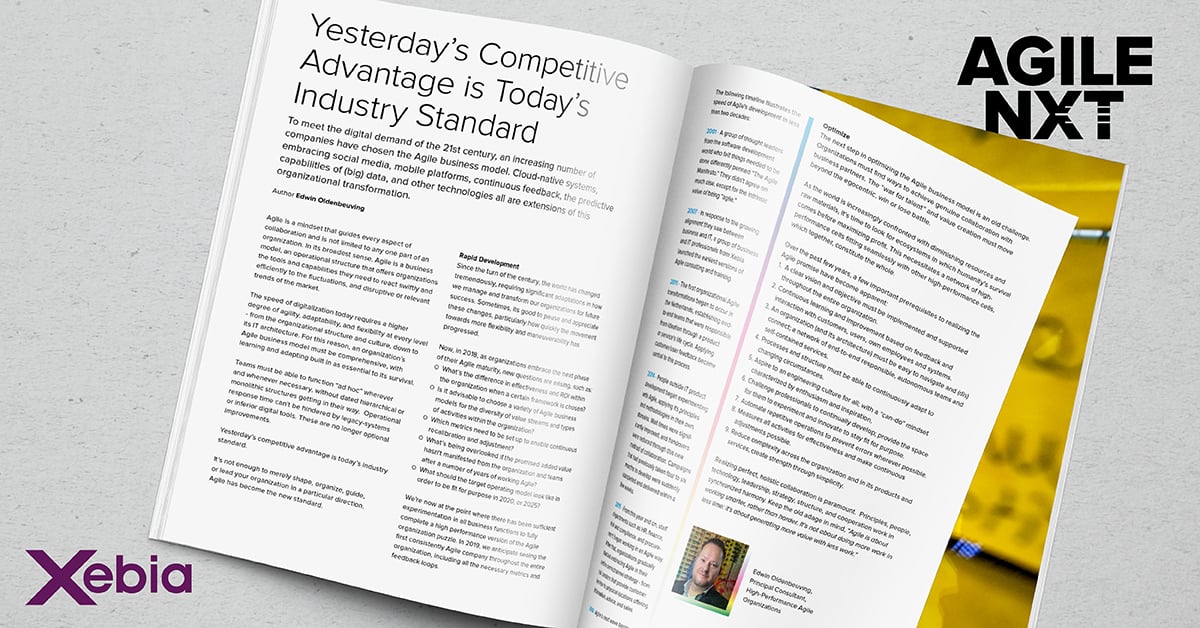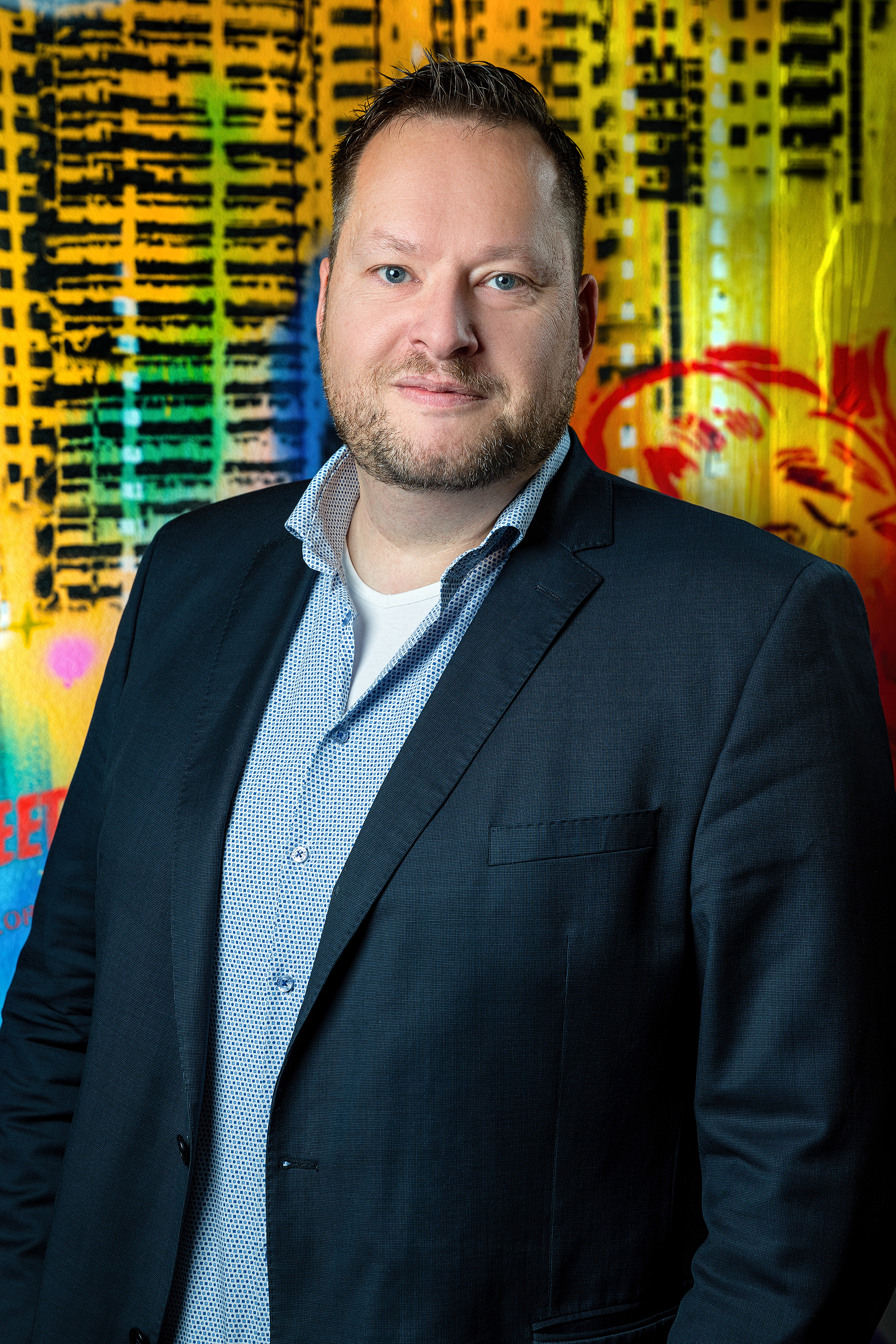To meet the digital demand of the 21st century, an increasing number of companies have chosen the Agile business model. Cloud-native systems, embracing social media, mobile platforms, continuous feedback, the predictive capabilities of (big) data, and other technologies all are extensions of this organizational transformation.
Agile is a mindset that guides every aspect of collaboration and is not limited to any one part of an organization. In its broadest sense, Agile is a business model, an operational structure that offers organizations the tools and capabilities they need to react swiftly and efficiently to the fluctuations, and disruptive or relevant trends of the market. This article is published in
This article is published in  . Agile NXT is a new magazine full of inspiration for professionals on the emerging Agile journey. It challenges you to think differently and improve yourself, your team, and company a little more each day.
. Agile NXT is a new magazine full of inspiration for professionals on the emerging Agile journey. It challenges you to think differently and improve yourself, your team, and company a little more each day.
The speed of digitalization today requires a higher degree of agility, adaptability, and flexibility at every level - from the organizational structure and culture, down to its IT architecture. For this reason, an organization’s Agile business model must be comprehensive, with learning and adapting built in as essential to its survival.
Teams must be able to function “ad hoc” wherever and whenever necessary, without dated hierarchical or monolithic structures getting in their way. Operational response time can’t be hindered by legacy-systems or inferior digital tools. These are no longer optional improvements.
Yesterday’s competitive advantage is today’s industry standard.
It’s not enough to merely shape, organize, guide, or lead your organization in a particular direction. Agile has become the new standard.
Rapid Development
Since the turn of the century, the world has changed tremendously, requiring significant adaptations in how we manage and transform our organizations for future success. Sometimes, its good to pause and appreciate these changes, particularly how quickly the movement towards more flexibility and maneuverability has
progressed.
Now, in 2018, as organizations embrace the next phase of their Agile maturity, new questions are arising, such as:
- What’s the difference in effectiveness and ROI within the organization when a certain framework is chosen?
- Is it advisable to choose a variety of Agile business models for the diversity of value streams and types of activities within the organization?
- Which metrics need to be set up to enable continuous recalibration and adjustment?
- What’s being overlooked if the promised added value hasn't manifested from the organization and teams after a number of years of working Agile?
- What should the target operating model look like in order to be fit for purpose in 2020, or 2025?
We’re now at the point where there has been sufficient experimentation in all business functions to fully complete a high performance version of the Agile organization puzzle. In 2019, we anticipate seeing the first consistently Agile company throughout the entire organization, including all the necessary metrics and feedback loops.
Optimize
The next step in optimizing the Agile business model is an old challenge. Organizations must find ways to achieve genuine collaboration with business partners. The “war for talent” and value creation must move beyond the egocentric, win or lose battle.
As the world is increasingly confronted with diminishing resources and raw materials, it’s time to look for ecosystems in which humanity's survival comes before maximizing profit. This necessitates a network of high-performance cells fitting seamlessly with other high-performance cells, which together, constitute the whole.
Over the past few years, a few important prerequisites to realizing the Agile promise have become apparent:
- A clear vision and objective must be implemented and supported throughout the entire organization.
- Continuous learning and improvement based on feedback and interaction with customers, users, own employees and systems.
- An organization (and its architecture) must be easy to navigate and (dis)connect; a network of end-to-end responsible, autonomous teams and self-contained services.
- Processes and structure must be able to continuously adapt to changing circumstances.
- Aspire to an engineering culture for all; with a “can-do” mindset characterized by enthusiasm and inspiration.
- Challenge professionals to continually develop; provide the space for them to experiment and innovate to stay fit for purpose.
- Automate repetitive operations to prevent errors wherever possible.
- Measures all activities for effectiveness and make continuous adjustments possible.
- Reduce complexity across the organization and in its products and services; create strength through simplicity.
Realizing perfect, holistic collaboration is paramount. Principles, people, technology, leadership, strategy, structure, and cooperation work in synchronized harmony. Keep the old adage in mind, “Agile is about working smarter, rather than harder. It's not about doing more work in
less time: it's about generating more value with less work.”
The following timeline illustrates the speed of Agile's development in less than two decades:
2001 - A group of thought leaders from the software development
world who felt things needed to be done differently penned “The Agile
Manifesto.” They didn't agree on much else, except for the intrinsic value of being “agile.”
2007 - In response to the growing alignment they saw between
business and IT, a group of business and IT professionals from Xebia
launched the earliest versions of Agile consulting and training.
2011 - The first organizational Agile transformations began to occur in the Netherlands, establishing end-to-end teams that were responsible from ideation through a product
or service’s life cycle. Applying customer/user feedback became central to this process.
2014 - People outside IT product development began experimenting with Agile, applying its principles and methodologies in their own domains. Wait times were significantly improved, and handovers were reduced through this new method of collaboration. Campaigns that had previously taken four to six months to develop were suddenly completed and delivered within a few weeks.
2015 - From this year and on, staff departments such as HR, finance, risk and compliance, and procurement began working in an Agile way. After that, organizations gradually started embracing Agile in their entire omni-channel strategy - from call centers that provide customer service to physical locations offering
information, advice, and sales.
2018 - Agile’s next wave begins.
Want to know more about this topic? Download  and change your tomorrow. Or join us at AGILENXT.com for the latest Agility content and Conferences.
and change your tomorrow. Or join us at AGILENXT.com for the latest Agility content and Conferences.





